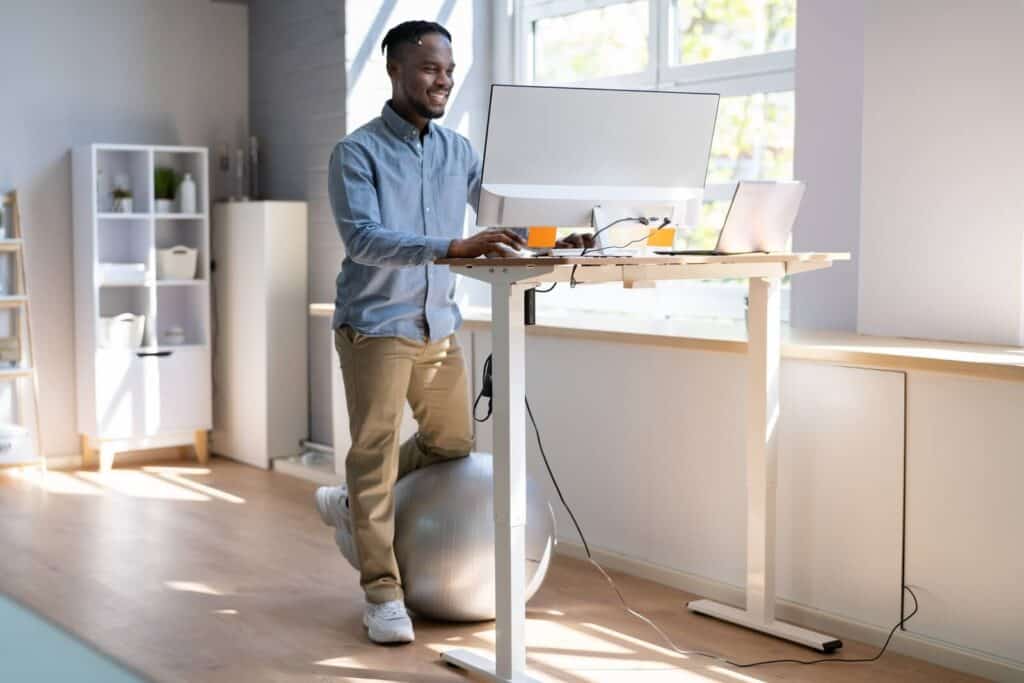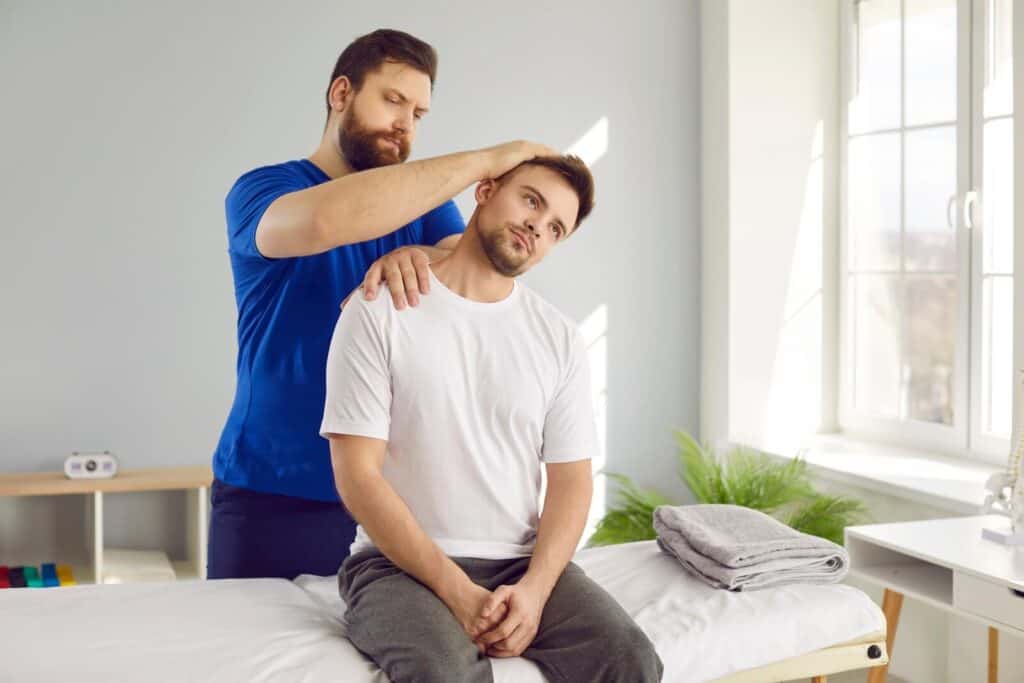In our digital world, it's easy to spend hours looking down at a screen—whether it's a smartphone, laptop, or tablet. Over time, this habit can lead to "tech neck," a condition that causes stiffness, soreness, and even long-term postural problems. Tech neck doesn’t just affect your comfort; it can lead to chronic pain, headaches, and muscle strain. The good news? With a few adjustments to your posture, habits, and workstation, you can reduce or even eliminate tech neck altogether.
Causes of Tech Neck

Tech neck, also known as “text neck” or “screen neck,” develops from repetitive strain on the neck and upper back due to prolonged screen use. One of the biggest culprits is looking down at smartphones, which places excessive pressure on the cervical spine. Poor posture, such as hunching over a desk or slouching in a chair, further worsens the issue.
A poorly set-up workstation at the office or home can also contribute to tech neck. According to research from PMC, 65% of people who work from home have neck or back pain. Sitting too low in relation to a computer screen or using a chair without proper lumbar support can strain the neck muscles. Additionally, lack of movement throughout the day tightens muscles and reduces flexibility.
Other daily habits, like cradling a phone between the shoulder and ear or carrying heavy bags that pull the shoulders forward, can add to the strain. Recognizing these causes is the first step toward making changes that can prevent tech neck and its associated discomfort.
Tech Neck Symptoms

Tech neck often starts with mild discomfort but can quickly progress to more serious issues if left unaddressed. Common symptoms include:
- Stiffness and soreness in the neck and shoulders.
- Persistent headaches, often tension-related.
- Muscle fatigue or weakness in the upper back and neck.
- Reduced range of motion, making it harder to turn the head.
- Numbness or tingling in the arms and hands (in severe cases).
Over time, untreated text neck can lead to chronic pain, changes in posture, and even long-term spinal misalignment. If you’re experiencing tech neck symptoms regularly, it's time to take action to prevent further strain on your neck and shoulders.
11 Tips for How to Fix Tech Neck

The good news is that this condition is preventable—and even reversible—with simple changes to your posture, ergonomics, and daily habits. Small adjustments like raising your screen, improving your sitting position, and incorporating movement into your routine can significantly reduce neck strain. By being mindful of how you interact with digital devices, you can alleviate discomfort and prevent long-term damage. Below are 11 practical tips to help fix tech neck and keep your posture in check.
1. Keep Your Screen at Eye Level
One of the easiest ways to prevent tech neck is to adjust your screen height. Whether you're using a computer, tablet, or smartphone, keeping your screen at eye level reduces the need to bend your neck downward. Use a monitor stand or stack books under your laptop to elevate it. If you're using a phone, hold it higher rather than constantly looking down. Making this simple change helps keep your spine in a more natural alignment.
2. Maintain a Neutral Spine Posture
Your posture plays a significant role in preventing screen neck. Aim to keep your shoulders back, your chin slightly tucked, and your ears aligned with your shoulders. Avoid hunching forward or rounding your upper back, as this puts extra strain on your neck and spine. Sitting straight back and engaging your core muscles can help maintain a neutral posture and reduce pressure on your cervical vertebrae.
3. Take Frequent Breaks to Reduce Strain
Sitting or looking down at a screen for long periods tightens muscles and increases strain on your neck. To counteract this, take breaks every 30 to 60 minutes. Stand up, stretch your neck and shoulders, or take a short walk to reset your posture. Setting reminders on your phone or using a standing desk can encourage movement and prevent prolonged strain. Even small breaks throughout the day can make a big difference in reducing tech neck symptoms.
4. Strengthen Your Neck and Upper Back

Weak neck and upper back muscles contribute to poor posture and tech neck discomfort. Strengthening these muscles can improve support for your spine and reduce strain. Simple exercises like chin tucks, where you gently pull your chin back to create a “double chin,” help align your head with your spine. Shoulder blade squeezes—pulling your shoulder blades together and holding for a few seconds—help counteract the forward hunch caused by prolonged screen use. Incorporating these exercises into your routine can improve posture, reduce stiffness, and prevent long-term discomfort.
5. Use a Supportive Office Chair
An ergonomic office chair with proper lumbar and neck support can help you maintain a natural sitting posture and prevent tech neck. Look for a chair that supports the natural curve of your spine and allows you to sit with your feet flat on the floor. Adjustable headrests and armrests can also help keep your posture aligned and reduce unnecessary strain on your neck throughout the day. Investing in the right chair can make a significant difference in reducing discomfort and promoting better posture.
6. Hold Your Phone at Eye Level
One of the biggest contributors to tech neck is constantly looking down at your phone. Hold your phone at eye level instead of tilting your head forward to keep your spine aligned. If you're reading or watching something for an extended period, use a phone stand or prop your device up on a stable surface. Making this small adjustment in how you use your phone helps reduce neck strain and is an option for spine treatment without surgery.
7. Practice Chin Tucks and Neck Stretches
Daily neck stretches and exercises can help relieve tightness, improve flexibility, and strengthen the muscles supporting your spine. Chin tucks are a simple but effective exercise—gently pull your chin back to align your head with your spine, hold for a few seconds, and release. Neck rolls help loosen stiff muscles, while shoulder stretches counteract the forward hunch caused by prolonged screen use. Incorporating these movements into your daily routine can prevent stiffness and keep your neck mobile and pain-free.
8. Switch to a Standing Desk Periodically

Alternating between sitting and standing throughout the day can significantly reduce the strain on your neck and back. A standing desk allows for better posture control by keeping your screen at eye level and preventing prolonged pressure on your cervical spine. If a standing desk isn’t an option, try taking standing breaks every 30 to 60 minutes to reset your posture and reduce stiffness.
9. Adjust Your Keyboard and Mouse Position
Your keyboard and mouse placement play a crucial role in maintaining good posture. Position them so that your arms rest comfortably at a 90-degree angle, preventing unnecessary shoulder and neck tension. A wrist rest can help keep your hands aligned, while keeping your elbows close to your body reduces strain on your upper back. A well-optimized workstation can make a big difference in preventing tech neck discomfort.
10. Apply Heat or Ice for Relief
If you’re experiencing soreness or stiffness from tech neck, heat and cold therapy can help. A heating pad can loosen tight muscles and increase blood flow, while an ice pack can reduce inflammation and numb pain. For the best results, try applying ice for the first 48 to 72 hours to minimize swelling before switching to heat therapy to relax the muscles. Alternating between heat and cold therapy can provide effective relief, especially after long hours at a desk.
11. Get Professional Tech Neck Treatment if Needed
If screen neck pain becomes persistent or severe, it may be time to seek professional help. A chiropractor, physical therapist, or massage therapist can provide targeted treatments to relieve tension, improve posture, and strengthen supporting muscles. Manual therapy, posture retraining, and specialized exercises can offer long-term relief and prevent further strain. Consulting with a Northeast Spine and Sports Medicine provider ensures you get personalized strategies to keep your neck healthy and pain-free.
Frequently Asked Questions About Tech Neck

How Do I Prevent Tech Neck in the First Place?
If you are wondering how to prevent tech neck, the best way is through preventive habits. Maintain good posture by keeping your screen at eye level, whether it’s a computer monitor or a phone. Take regular breaks every 30–60 minutes to stretch and move around. Set up an ergonomic workstation with a chair that provides lumbar and neck support. Strengthen your neck and upper back with exercises like chin tucks and shoulder blade squeezes. The earlier you implement these changes, the less likely you are to develop tech neck discomfort.
Can Tech Neck Be Reversed?
Yes! Tech neck can be reversed with proper treatment, posture correction, and muscle strengthening. Incorporating daily neck stretches, adjusting your workstation ergonomics, and using heat or ice therapy for relief can help ease symptoms over time. Chiropractic care, physical therapy, and massage therapy can also accelerate recovery. However, lasting improvement requires long-term habit changes, such as sitting with a neutral spine, avoiding prolonged screen use, and strengthening supporting muscles.
What Should I Do If Tech Neck Pain Won’t Stop?
If tech neck pain persists despite self-care measures, it may be time to seek professional treatment. A chiropractor, physical therapist, or pain specialist can assess your condition and recommend targeted treatments, including manual therapy, postural retraining, and corrective exercises. If left untreated, tech neck can lead to chronic pain management and more severe spinal issues. Don’t ignore ongoing discomfort—getting professional help can provide long-term relief and prevent further complications.
Seek Expert Care with NorthEast Spine and Sports Medicine

Northeast Spine and Sports Medicine is a multidisciplinary practice offering expert care for tech neck and other musculoskeletal conditions across New Jersey. Our chiropractors, physical therapists, and pain specialists provide chiropractic adjustments, physical therapy, and posture correction to relieve pain and improve mobility.
If tech neck symptoms persist, professional care can help. Contact Northeast Spine and Sports Medicine at (848) 360-4667 or book an appointment online to start feeling better today.


